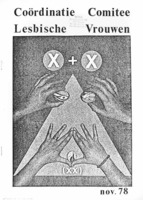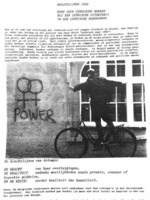BAL * Note taker, note teller, list of possible fortunes
BAL, Brussel Almanack Lesbian is a digital collection of ephemera from the queer and lesbian grassroots movements in Brussels and Belgium. It contains material gathered from both personal and public archives and has been shared with the public through exhibitions, a publication and a reading room. The original structure of the collection is made out of lists; lists of spaces, political movements, bars and parties, lesbian slang and alphabets; mythologies, mysteries and manifestos. Simple documents that could be passed around to different people with the question «does this make sense to you? Is something missing?»
We have long been interested in examples of how to structure such a subjective collection as it started to resemble an archive on its own. Questions around privacy and accessibility, categorization and referencing have circled the project since the start. During Unbound Libraries we were taken by the brilliance of how Mayday Rooms had created a “tactics” category for parts of their archive. The sharing of tactics seemed as a sharing of advice, of care and cunning, and it put emphasis on a cross-chronological community where knowledge was passed on to the person coming after.
With BAL being based on lists of ephemera, the truthfulness in each fragment has always been in what it means to the person looking at it, not how well referenced it is in general history or big of an event it was to others. Therefore it is not only a subjective collection, but a collection that demands to be interpreted in a subjective way.
The different exhibitions and outputs of the BAL-collection have always come with a fortune teller made out of bits of archival material, something we have often regarded simply as a by-product or a bonus. During Unbound Libraries worksession in 2020 we also ended up making a fortune teller for the participants as a way to share some of our material in a personal and subjective way. It has also felt like a method that stood close to the material shared, as interpretive reading such as the fortune tellers is central for many queer scenes. Perhaps the appeal of it being that it is quite pleasant to search for alternative ways of making sense of the universe if the customs and systems of the society have been drawn up without you in mind.
In terms of passing on advice, tactics and care, through the imagery of our visually rich collection, developing a larger fortune teller started to seem like a logical way to share our archive in the future. As an open invitation asking the receiver to specifically interpret what the fragment means to them. This idea was also in line with another strong influence we picked up during Unbound Libraries; Clara Balaguer’s engagement with note-taking as an essential function and role in a conversation. Note-taking felt to us like a caring writing genre to work with and position to work from in formulating our archival fragment fortunes. To write a fortune but also the reference of the image-fragment. Short sentenced, concise and informative.
As a thinking tool during the work session we were ourselves taking notes in form of a list of what has given shape to our BAL-lists. To map out what we did in the past so that we could know more precisely what to do in the future. It was a list of what had originally shaped our list.
Here we have re-formatted it, and so we present you our list in the format of a fortune teller:
[If you wish to use this fortune teller, before you start reading, think of a number between 1-16, and interpret the corresponding sentence & visual fragment to guide you through the rest of this day.]
1
Gather fragments of histories made by lesbians( ♥ ) rather than history that happened to lesbians. * **
* Not giving visibility to violence but to empowerment.
** To paraphrase Eve Kosofsky Sedgwick; Working to create reparative rather than paranoid reading.
FRAGMENT SOURCE: New Women Times, 1980, from Rosa Archive
2
We consciously use the term lesbian( ♥ ) to care for its ownership, visibility and political associations.
( ♥ )Lesbian in this project is used to embrace and celebrate all possible forms of love and intimacy between people who identify on the female side of the gender spectrum, who have identified as such or have been ascribed a female gender at some point in their lives.
FRAGMENT SOURCE: Clit 007, 1984, from BAL archive
3
We are proudly incomplete (non exhaustive)
FRAGMENT SOURCE: Lady Comedie in Lesbies Doe-Front, 1988, Fonds Suzan Daniel archive
4
Mostly focused on ephemera (flyers, menus, paper programs, member cards, booklets, stapled publications, buttons…)
FRAGMENT SOURCE: Le quotidien des femmes, 1976, Rosa archive
5
Mostly based on digital pictures / reproductions (not originals) and a latent physicality (facsimilés, fortunes, invitations to photocopy)
FRAGMENT SOURCE: Vrouwenwoorden, 1984, AVG-Carhif archive
6
Our work is informed by and echoes the materiality, conditions/means of production of what we encountered (mostly photocopied flyers, booklets, newsletters, mostly flat elements…) — and cherishes its limited means (foldings, colored papers, etc)*
* The same way as Mayday Room is an archive of archiving methods, we are archiving reproduction methods and forms – How to take on board the heritage of the production as well as content
FRAGMENT SOURCE: Illustration from Maison des femmes, 1976, from Rosa Archive
7
We are not the original makers or holders (even though we have archives and this becomes a growing thing*) so crediting is very important.
* Relations/relay/movements between public archives and personal ones (donation to an archive, gifts to us borrowing/thefts from archives…)
FRAGMENT SOURCE: Gaia guide, ca 1986, archive of Marian Lens
8
We work bottom-up, small scale, non institutional, not coming from an archiving background.
FRAGMENT SOURCE: Magazine Les Lesbianaires, 1983, AVG-Carhif archive
9
We are not sure if we are an archive, but we might look like one.*
* We started with a spatial presentation + publication
FRAGMENT SOURCE: Members card, De Paarse Peperpot, ca 1985, AVG-Carhif archive
10
We function in connection with other groups/projects/archives/organisations.*
* We were born(e) out as a sister-project of Mothers & Daughters – A lesbian and trans bar
FRAGMENT SOURCE: Magazine Les Lesbianaires, 1982, AVG-Carhif archive
11
We are also not sure if we are a collective but we often work like one.
FRAGMENT SOURCE: Coordinatie Comitee Lesbische Vrouwen, 1978, AVG-Carhif archive
12
We love lists as a way to build and organize.
FRAGMENT SOURCE: ’t Knal-potteke, 1978, Rosa Archive
13
We wish to credit while veiling identity — honoring both being out and the many rooms of the closet – and we are always up for playing hide and seek.
FRAGMENT SOURCE: Campagn/action for bookstore Artemys, 1992, archive of Marian Lens
14
We wish to emphasise the collective volume while protecting the individual.
FRAGMENT SOURCE: Portrait of Marian Lens, ca 1992, archive of Marian Lens
15
We work to not creating a too precious archive, humour is essential and purity is not an option
FRAGMENT SOURCE: New Women Times, 1980, from Rosa Archive
16
We use items, fragments, methods and ephemera to guide us towards the right voices, spaces and personal stories. The context is as important and collectable as the content.
FRAGMENT SOURCE: Magazine Les Lesbianaires, 1983, AVG-Carhif archive















